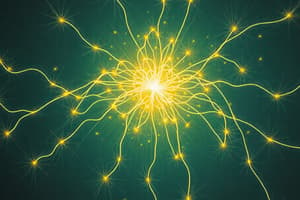Podcast
Questions and Answers
What is the direction of the dipole moment vector in a system?
What is the direction of the dipole moment vector in a system?
The dipole moment vector points from the negative charge to the positive charge.
What is the unit of dipole moment in the SI system?
What is the unit of dipole moment in the SI system?
Coulomb-meter (C·m)
What is the characteristic of electric field lines around a dipole?
What is the characteristic of electric field lines around a dipole?
The field lines are denser near the charges and less dense farther away.
What is the formula for the torque on a dipole in an electric field?
What is the formula for the torque on a dipole in an electric field?
What is the direction of rotation of a dipole in an electric field?
What is the direction of rotation of a dipole in an electric field?
What is the condition for maximum torque on a dipole in an electric field?
What is the condition for maximum torque on a dipole in an electric field?
What is the behavior of electric field lines around a positive charge?
What is the behavior of electric field lines around a positive charge?
What is the effect of the electric field on the rotation of a dipole?
What is the effect of the electric field on the rotation of a dipole?
What is the unit of torque on a dipole in an electric field?
What is the unit of torque on a dipole in an electric field?
What is the characteristic of electric field lines in terms of their density?
What is the characteristic of electric field lines in terms of their density?
Flashcards are hidden until you start studying
Study Notes
Dipole Moment
- Definition: A dipole moment is a measure of the separation of positive and negative electric charges in a system.
- Formula: p = q × d, where p is the dipole moment, q is the magnitude of the charge, and d is the distance between the charges.
- Unit: Debye (D) or coulomb-meter (C·m)
- Characteristics:
- A dipole has a positive charge on one end and a negative charge on the other end.
- The dipole moment is a vector quantity, pointing from the negative charge to the positive charge.
Electric Field Lines
- Definition: Electric field lines are imaginary lines that emerge from positive charges and enter negative charges.
- Characteristics:
- Electric field lines are continuous and unbroken.
- They emerge from positive charges and enter negative charges.
- Field lines are denser where the electric field is stronger.
- Electric field lines can be used to visualize the direction and strength of the electric field.
- Behavior around a dipole:
- Field lines emerge from the positive charge and enter the negative charge.
- The field lines are denser near the charges and less dense farther away.
Torque and Rotation
- Torque (τ) on a dipole in an electric field (E):
- Formula: τ = p × E
- Unit: newton-meter (N·m)
- Characteristics:
- The torque on a dipole is maximum when the dipole is perpendicular to the electric field.
- The torque is zero when the dipole is parallel or antiparallel to the electric field.
- Rotation of a dipole in an electric field:
- The dipole will rotate to align itself with the electric field, minimizing its potential energy.
- The direction of rotation is determined by the right-hand rule.
Dipole Moment
- A dipole moment is a measure of the separation of positive and negative electric charges in a system.
- The formula to calculate the dipole moment is p = q × d, where p is the dipole moment, q is the magnitude of the charge, and d is the distance between the charges.
- The unit of dipole moment is Debye (D) or coulomb-meter (C·m).
Characteristics of Dipole
- A dipole has a positive charge on one end and a negative charge on the other end.
- The dipole moment is a vector quantity, pointing from the negative charge to the positive charge.
Electric Field Lines
- Electric field lines are imaginary lines that emerge from positive charges and enter negative charges.
- Electric field lines are continuous and unbroken.
- They emerge from positive charges and enter negative charges.
- Field lines are denser where the electric field is stronger.
- Electric field lines can be used to visualize the direction and strength of the electric field.
Behavior of Electric Field Lines around a Dipole
- Field lines emerge from the positive charge and enter the negative charge.
- The field lines are denser near the charges and less dense farther away.
Torque and Rotation
- The torque (τ) on a dipole in an electric field (E) is calculated by the formula τ = p × E.
- The unit of torque is newton-meter (N·m).
- The torque on a dipole is maximum when the dipole is perpendicular to the electric field.
- The torque is zero when the dipole is parallel or antiparallel to the electric field.
- The dipole will rotate to align itself with the electric field, minimizing its potential energy.
- The direction of rotation is determined by the right-hand rule.
Studying That Suits You
Use AI to generate personalized quizzes and flashcards to suit your learning preferences.




